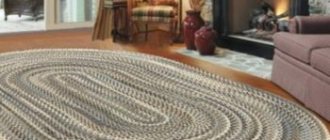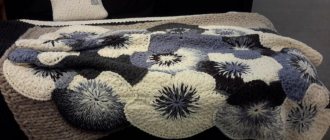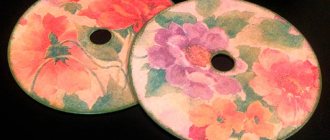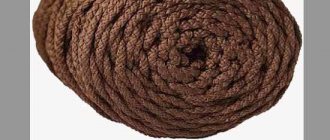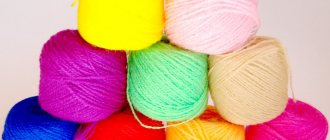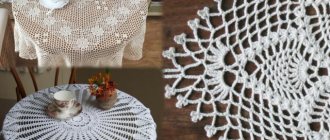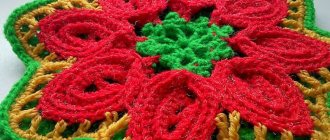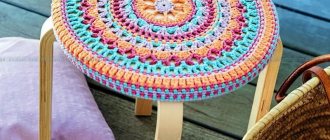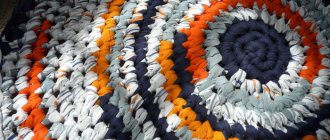Housewives try to make their home cozy. Crocheted curtains for the kitchen, living room, bedroom, and dining room will be an excellent decor. With them, any interior will be complemented.
Knitted curtains add comfort and coziness to any room.
The master quickly produces airy curtains and napkins. However, beginners will also be able to create such a product if they have basic knowledge and a little experience with air loops and connecting type posts. The review contains all the necessary information about crocheting patterns.
Natural materials
Cotton threads of the “iris” type are distinguished by smooth fibers; when crocheting, they do not tangle or curl. This cotton material is dyed in all shades of 7 basic colors. The advantage of these threads is that they do not discolor or fade over time, although they are made of pure cotton.
Linen threads are also 100% natural, but rough and subdued in color. To obtain a richer shade, polyester synthetic fibers are added to them. Linen products have a pronounced texture and are practically impossible to smooth out.
The properties are similar to linen bamboo fibers, but they do not wrinkle and can be ironed perfectly.
Wool threads are distinguished by their elastic strength, which do not wrinkle and stretch well.
Silk threads are distinguished by a full-color palette. Their peculiarity is that, depending on the lighting, the already saturated shades can shimmer with all the colors of the rainbow. They are durable and very durable.
Silk and cotton threads are considered the most suitable for hand-crocheting miniature curtains for the bedroom (or kitchen). If the goal is to knit a large thick curtain, then you need to choose bulky linen or wool threads.
How to knit curtains from round motifs
Crocheting curtains from motifs is also interesting, one or two motifs at a time and we will quietly arrive at the desired result. And they turn out simply gorgeous!
I offer you diagrams of three interesting models and even four - we have a diagram and description of one similar popular curtain in a separate old post.
This is a very beautiful and somewhat unusual motif, framed with openwork mesh. Between the motives for connection there are small simple motives.
First we knit one large motif, and then when knitting the second and each next one in the last row, we connect them together using two toes on each side.
Intermediate motifs can be knitted immediately or after completing the knitting of all large motifs, connecting with them.
There is no border here, the circular motifs themselves create a beautiful edge.
For a detailed master class on knitting and combining motifs, watch my video.
Hook selection
In order for a knitted product to be beautiful and the loops to be even, in addition to the skill of the needlewoman, a normal tool is required, i.e. Crochet hook. Dense and thick threads require a large hook, the diameter of which corresponds to the thickness of the yarn. Thin threads are knitted with small hooks or knitting needles. For woolen threads, choose hooks made of plastic, for thin threads - metal ones.
Knitted curtain with openwork butterflies
Curtain size 48*100 cm, butterflies – 9*12 cm each. To work you will need:
- Threads (cotton 100%, 260 m per 50 g) 300 g;
- Hook No. 1.25;
- Satin ribbon;
- Markers for knitting ornaments.
Knitting density 10*10 cm or 18*20 cells.
Markers for making patterns
When working with this model, you need several patterns at once:
- Sirloin knitting. Each cell consists of 3 loops, while each free cell is 1 stitch with one or two crochets and 2 ins. p. A full square is 3 double crochets;
- Pattern for inner motif and top edge;
- Diagram for a butterfly.
Description of work:
Dial 262 v. n. Continue knitting the internal motifs and the top edge according to the second pattern. Starting from the 9th row, knit the upper and lower parts separately. In the 44th row, make a connection using 2 v. p. Then continue whole knitting until the 58th row. The given figure in diagram one must be repeated 4 times. Finish the curtain with a row of double crochets.
Description of work for butterfly:
- The work begins with knitting the body. To do this you need to dial 25 v. p. and turn the knitting.
- Dial 3 v. p. for lifting, knit with double crochets to the end of the row.
- Continue knitting according to the pattern, ending all circles with a connecting stitch.
- Future wings are knitted with loops only behind the back walls.
- Finish the work, leaving a thread 1.5 m long.
- To decorate the lower wing, you need to attach a new thread at arrow 3 in the diagram.
- Dial 30 v. etc., close it into a ring with a connecting post. Knit the wing according to the pattern in the forward and reverse directions.
- For the upper left wing, attach a new thread at arrow 2. Cast on 40 stitches. etc., close it into a ring with a connecting post. Continue knitting according to the pattern in two directions.
- Finish knitting, cut and fasten the thread. Knit the right wing in the same way, only in a mirror way.
- After completing all the work, tie the remaining thread around the body in one row behind the back wall. A total of 8 butterflies are needed.
Curtain assembly:
- Stretch the finished curtain, cover with a cloth slightly moistened with starched water and leave to dry.
- Do the same with butterflies.
- Iron both the curtains and the butterflies.
- Attach the butterflies to green satin ribbons, as in the photo.
Choosing curtain designs for different rooms
Each room has its own meaning. Therefore, the curtains for each of them should not be the same as in other rooms. Another important aspect is the direction of the window, because... The illumination of the room depends on the direction of the world. For southern windows you need to knit long (completely covering the window sashes) and dense fabrics that disperse the sun's rays well. For dimly lit rooms, you can opt for loose knitting patterns and choose short curtain models.
For kitchens and other non-residential rooms
The kitchen is the most functional place in the home and requires the most practical curtains. Any surface in the kitchen can serve as a work surface, including the window sill. Consequently, curtains are required here not for the entire window, but covering only part of it. Such small items are easy to crochet.
Since the curtain will be washed often, you need to select the strongest possible yarn and patterns with the highest knitting density, then the appearance of the curtain will last longer. When crocheting, the bottom edge of the curtain does not have to be straight; it is better to make it in the shape of flowers or leaves. You can also crochet a fringe, a rounded or wavy edge.
For the bedroom
In the bedroom, long floor-length curtains, decorated with a complex patterned composition, look best. French motifs are appropriate in the bedroom or when the canvas is decorated with tassels or fringe and slightly gathered. When the curtains are long, it is better to make them in the form of two panels, separated in the middle of the window, so that access to the balcony or to the window itself is provided.
In this case, canvases are allowed in different colors, and their number is more than two. The traditional option looks good when the light curtains are in the center and closer to the window, and the dark ones are on the sides, on top of the light ones.
For children's
In the children's room, there are organic curtains with fairy-tale motifs: animals, trees, cartoon characters. Preferably the so-called fillet crochet. This means that the pattern is knitted in a tight pattern (single crochet), as a result, the children's room can do without thick night curtains.
Knitted curtains in the interior: description, models for the living room, bedroom, kitchen, photos
Knitted curtains will decorate any room. But it just so happens that they are more often used to decorate the kitchen. Perhaps this is explained by the fact that there is a need for more work space, and zealous housewives are ready to use even window sills for their purposes. In this case, short curtains will come in handy: the window opening is adequately decorated and it’s easy to approach the window sill.
A short curtain will leave the window sill free
Crocheted curtains are appropriate not only in the country house. This decor looks very stylish in modern apartments and houses.
And even frankly rustic motifs do not look like an outdated element if they are made in the same manner, for example, with a tablecloth or napkins.
You can combine handmade curtains with other knitted products
Another non-standard solution for the kitchen: a curtain made of napkins of different sizes, colors and shapes. The decision is very bold. Only a self-sufficient housewife, confident in her own impeccable taste, can afford this.
A very original solution, ideal for a home in which the atmosphere is created with soul
In the bedroom you can hang some kind of French curtains. Knitted from small motifs connected to each other, such curtains make the interior luxurious and romantic. Curtains made of thick fabric, decorated with “airy” knitted elements, add functionality to the entire design.
DIY French curtain
Handmade curtains in the living room look especially elegant. The design of the curtains can be different: just two long sheets, or supplemented with a lambrequin and holders for the sheets.
Short crocheted curtain
The interior must include wooden furniture, as well as handmade tablecloths, napkins and pillows.
Another interesting solution for the living room is an analogue of thread curtains. The natural color of the threads chosen for decoration is in harmony with the decoration of the walls. The photo shows that the interior contains pillows and napkins of the same color scheme. The laconic lamp and the shape of the furniture complement the overall design solution.
A successful combination of thread curtains with decorative pillows
In this case, pastel pink curtains are complemented by plain drapes of the same color. Since natural fabric was chosen for the curtains, the result was a wonderful ensemble.
Such curtains will create a romantic atmosphere
Synthetic drapes or curtains with bright patterns are not suitable for handmade tulle.
“Hand made” is used even more widely in the design of a children’s room. For example, a bright knitted curtain made from simple motifs will decorate a window opening. Thanks to this element of the interior, the room looks sunny and spacious.
Curtain for children's room in bright colors
And if preference is given to classic curtains and tulle, then the use of unusual curtain ties will remind you that this room is the habitat of small family members, and all decorative elements should remind of this.
Knitted tiebacks in the shape of leaves
Handmade curtain tiebacks are also relevant in the interior of a living room or bedroom. They will decorate the most casual curtain and make the interior more romantic.
Another way to decorate the interior is to complement ordinary (possibly boring) curtains with knitted decor. This can be a lambrequin or simply a wide handmade braid attached to the top of the curtain.
How to crochet curtains using ready-made patterns
Check out the DIY curtain models shared by our needlewomen. In any case, along the upper edge of the fabric there is an empty section of fillet knitting, through which the curtain rod passes, from which the curtain is hung. Below this section, the pattern itself is made according to the diagram.
We offer several models of the most successful knitting. Our great-grandmothers often crocheted small curtains for the kitchen; today such needlework is becoming fashionable again. There are many crochet curtain patterns available, take any one. Even a novice needlewoman can knit a beautiful curtain for a country house or a rural mansion. You just need to find a nice pattern, threads, a hook and free time for creativity.
Knit according to the pattern
To correctly tie the curtains according to the proposed pattern, you first need to study it. Photos in sources are often accompanied by a detailed diagram. Simple patterns that any needlewoman can understand, are explained in detail by the attached photographs, and at each stage of knitting loops there is a description of the required actions.
Having understood several ways to knit chains of loops and stitches, any needlewoman will be able to crochet the most complex pattern according to the pattern, as well as come up with her own designs and patterns. Next, we offer several interesting “curtain” schemes
patterns.
Drunk butterflies
Crocheted according to the author's pattern called “drunk butterflies”. For some reason, the author of the idea called the pattern “drunk”; she was probably collecting locks from beer cans. The author also classified her creation as blinds, although it is closer to thread curtains, or muslin.
The essence of the idea is that each jar key is crocheted in the form of two butterfly wings. The two keys are connected into one, resulting in a design that looks like a butterfly. For the curtain, depending on its size, you will have to stock up on a large number of keys. They are tied with columns with different numbers of crochets.
When several of these butterflies are prepared, they can be connected with one vertical thread. These threads are sewn at one end to a horizontal braid, which is attached to the cornice. Such a curtain looks extravagant, but it does not move along the cornice, i.e. This is a decorative element that can be assembled using tiebacks.
Knitted kitchen curtain with pattern
Openwork curtains can be crocheted using several techniques. Let's list the common ones:
- Bruges lace is an imitation of ancient needlework made from rounded patterns.
- Irish lace is a mesh of connected parts knitted separately.
- Fillet lace - alternating loose mesh and dense sections according to the type of appliqué. This is how flowers, birds, still lifes and entire landscapes are knitted.
- Brumstick (so-called Peruvian lace) is an openwork fabric consisting of repeating motifs.
- Romanian lace - lace weaving is done along the canvas.
How to crochet curtains using ready-made patterns
For curtain knitting, choose natural threads with some added synthetics, then the finished fabric will keep its shape and retain its attractiveness without deforming after numerous washes. To work, it is enough to know only how air loops are crocheted and indicated on the diagrams, as well as stitches of 4 types: single crochet, 1, 2, 3 crochets. Once you master these 5 basic crochet elements, you can master any crochet idea.
Knitting technique
Crocheting is a fairly simple type of needlework that originates from antiquity. Any product begins from a chain of air loops, and the pattern is made up of sequentially located half-columns and columns with one or more crochets. You just need to carefully follow the diagrams that come with each product.
There are several techniques that are most often used.
Sirloin
A technique loved by many craftswomen. The pattern is knitted on the fabric in the form of a fillet mesh by alternating empty and filled (double crochets and chain stitches) cells. From such “filled” cells entire paintings are created on the canvas. The pattern is formed both along and across.
Products using the fillet technique can be assembled from different elements, connecting them together and creating original compositions. The yarn is preferably natural (linen or cotton), with the addition of viscose, which can make the product easier to care for and ensure durability.
Bruges
This is a more difficult technique to perform. It is often equated to Vologda lace, which, unlike Bruges, requires special devices.
The basis of Bruges lace is braid. It is from it that various patterns and compositions are made, connecting fragments with half-columns, single crochets or arches of air loops. If you need a lightweight openwork product, then you can use a mesh of air loops as a base. Using this technique, you can knit either a stand-alone fabric or complement a curtain knitted using another technique.
Irish lace
A very beautiful and, accordingly, complex technique. A pattern is laid out on a mesh canvas from parts made in advance. The composition is made up of separately related diverse elements. Therefore, it is very important to think in advance and make a pattern, a sketch of the ornament, as well as select a diagram and carefully follow it so that every detail is in its place. The mesh base can be decorative, French, or made using the fillet technique.
Broomstick
It is also called simple Peruvian knitting. This exotic technique comes from Peru. When knitting, any flat surface (ruler) or thick knitting needle is used, the role of which was previously played by a simple stick. Hence the name, which in English means “broomstick”.
The uniqueness of this technique lies in the loops stretched in a special way, with the help of which beautiful patterns are created. The product is voluminous and dense.
Kitchen curtain according to the “Village house” pattern
A curtain with a village street, bathed in bright sunshine, will protect the room from prying eyes. Strips of hearts are knitted between the rows of houses, which adds tenderness to the curtain. This type of crocheting with patterns only seems complicated, but in reality it will bring nothing but pleasure.
Curtains "Lace flowers" with scalloped edge
To work you will need:
- Threads (100% cotton, 380 m by 50 g), 350 g;
- Hook No. 1-1.25;
- White sewing threads;
- White cambric – 1.7 m.
Knitting is carried out using the fillet technique with a density of 14.5*14.5 cells or 10*10 cm. Border size: 60*15 cm.
Description of work:
The work begins with the formation of the outer scallops separately, rows from 14 to 74 are knitted across the entire width of the curtain and finished with scallops. For one festoon you need to knit a chain of 29 chains. p. and 4 v. p. for lifting, then knit according to the pattern up to the 12th row, including it. This way you need to knit only 7 festoons.
In the 13th row, all scallops need to be connected, making 3 stitches between them. p. The diagram shows only 5 elements, the rest are knitted in exactly the same way. The final ornament should look symmetrical.
After 74 rows you need to finish the festoons, each separately. Cut out the cambric, trim its edges and sew the border to the curtain.
Knitting pattern for curtains “Lace flowers”
Scheme of curtains “sun”
This curtain is crocheted in the “loin knitting” style. It scatters direct sunlight well and has a positive psychological effect. You won't buy anything like this in a store. The lovely sunshine on the entire window will improve your mood every time you look at your curtain. This is a simple interior decoration with a powerful positive psychological effect. Fillet knitting, dense in places, will gently diffuse bright sunlight and make the room much more comfortable.
Examples and photos of knitted curtains in the interior
An interesting composition for a small window. It's called "Cat House". It consists of an upper part that resembles a lambrequin and two simple panels at the bottom of the window.
The lambrequin is made of thin fabric to match the knitted lace
Handmade curtains can also be hung in the living room on a large window. The main thing is that the voluminous fabric is made of thin yarn.
If it is not possible to complement the interior with knitted curtains, then you can use interesting curtain ties. This will be the highlight of the design and will decorate the simplest curtains.
Handmade products will never go out of style. Hand-made interior items: curtains, pillows, tablecloths and napkins will add comfort and warmth.
Multi-colored crocheted curtain with pattern
Colored curtains, due to their diversity, are able to divert the eye from the flaws of the renovation and interior, because... are a bright accent. By choosing a combination of colors to suit your psychotype, you can create extraordinary comfort and a unique atmosphere in the room, which will work better than a psychotherapist. Bright multi-colored curtains of 3 or more colors radiate the euphoria of the holiday.
To knit them, you can use the remains of different threads. You can knit colorful curtains using different techniques; we offer our ideas with diagrams and descriptions.
Air curtain made of floral motifs
This very light airy openwork curtain is knitted from simple motifs - flowers. True, I didn’t look at the diagram carefully and knitted a flower with 12 petals instead of 16.
Similar to the first option, you first need to knit large motifs, and then small ones. The connection is made using two arches.
Please note: in the video in the 3rd row I knit two columns into arches, but you need three.
Curtains for the kitchen 7 crochet patterns
We offer 7 of the most interesting patterns for crocheting curtains for the kitchen:
- Openwork simplicity.
- Peacock close up.
- Friendly sunshine.
- In Garden style.
- Openwork motifs.
- Curtain border.
Openwork curtain “Angels”
For work: thread (100% cotton, 330 m by 50 g) approximately 150 g and hook No. 1-1.25. The size of the finished curtain is 34*80 cm. Knitting density: 17*16 cells or 10*10 cm.
Knitting process: dial 157 v. p. and continue working according to the scheme. In row 132 you need to make loops for the arch plank from c. p.: 3 c. p. instead of 1 double crochet, * 8 in. p., skip 7 loops, double crochet. Continue according to the pattern until the end of the pattern. Knitting is carried out using the fillet technique.
Knitted lambrequins
This textile element in the design of the window opening is the logical conclusion of the stylistic solution. A knitted lambrequin harmoniously combines with wicker curtains, as well as with curtains and curtains made from traditional materials: tulle, organza, cotton, linen, etc. When combining different materials, an interesting design technique would be to play with the fabric texture and color combination:
- On dense monochromatic curtains made of natural fabrics, a weightless air-knit lambrequin looks original. It will resemble a weightless cobweb through which the main fabric of the curtain shines through.
- Or vice versa, knitted from thick threads, a bright lambrequin will give a mischievous and touching look to a boring white curtain.
You can knit a lambrequin with crochet or knitting in several ways. By changing the top knitted patterns, you will add completely new color or stylistic accents and mood to the same curtain.
Tips for creating knitted curtains
Knitted curtains will delight you longer with their originality and attractiveness if you pay attention to these valuable tips:
- The curtain will be airier if you use a thin hook.
- After tying the curtain, first wash it, dry it naturally and iron it with a steamer. Only after this, hang it on the ledge.
- To prevent the curtain from sagging, starch it.
If you don't think you can knit a whole fabric, try starting with a border or curtain tie. Such a small element can become the main accent of the decoration, and it’s easy and quick to make.
Types of curtains: color, style, pattern
The kitchen is a specific room with high humidity, temperature changes, rapid contamination and other problems. Therefore, it requires careful selection of not only furniture, but also accessories. The materials from which they are made must be safe for health, easy to clean, wash or wash, and not lose their brightness when exposed to sunlight.
Crocheted curtains will be the best decoration for a country kitchen, despite the fact that they require constant care. It is better to choose floral motifs, various openwork patterns or pastoral images as patterns for them. It is better to use light shades of yarn and thread: beige, cream, pale blue, pale green, yellow, pink, lavender.
A win-win option would be pure white kitchen curtains. They will not only refresh the interior, but also make it more spacious, comfortable and serve as a backdrop for brighter objects. Among the popular types of curtains using the hand-knitting technique are:
- short lambrequins,
- cafe style curtains,
- direct options to the windowsill.
For a spacious room, you can crochet more voluminous floor-length curtains or decorated with patterns of bright yarn and threads. It would also be a good option to create your own curtain grips and other decorative elements.
